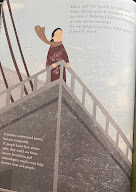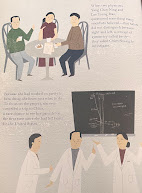This week I evaluated four informational picture books about different people, topics, and important events. I learned so much this week, I hope you do too!
1. Harris, R. H. (2024). It’s so amazing!: A book about eggs, sperm, birth, babies, gender, and families
(M. Emberley, Illus.). Candlewick Press.

Oh, how I wish I had access to a book like this when I was young. The ability to simply read about all of these things and learn about my body (with the aid of a curious cartoon bird and an easily embarrassed cartoon bee) would have drastically changed the course of my early adulthood. Now, enough about me. It's So Amazing is the ask-all tell-all book about bodies you wish you had as a kid.
Nothing is too taboo to be discussed in these pages. Harris and Emberly discuss everything from eggs & sperm to sexual intercourse, to adoption, to sexuality, to sexual abuse, and everything in between. They cover masturbation, they cover the growth of an embryo into a fetus, and the entire process of pregnancy. They have full color illustrations of nude men and women of all different ages and discuss what different bodies may or may not look like and how all of it is perfectly normal.


I recommend every librarian/ childcare professional/ teacher to have this on hand and ready to recommend to every parent or kid who has questions about these topics. Now, obviously checking with parents first is advised, but many children/teens do not have adults they can trust to tell them these things, and that can get very sticky. However, while using discretion, I fully believe that every child can benefit from the lighthearted and humorous (but still serious when it needs to be) approach to humanity and sexuality that this book has. The cartoon-style illustrations are anatomically correct without being vulgar, and the bright primary colors are attention-grabbing while still managing to take itself seriously on harder topics.
Bravo Harris and Emberly!
2. Robeson, T. (2019). Queen of physics: How Wu Chien Shiung helped unlock the secrets of the atom
(R. Huang, Illus.). Sterling Children’s Books.

Next up is the Queen of Physics herself: Wu Chien Shiung! Chien Shiung was born in Liuthe, China in a time when girls were not given many opportunities. However, as readers move through Queen of Physics, they will see how through her parents' drive, and her own bravery and persistence, she went to school for years and years and made lasting achievements in the field of physics.


Huang's 2D illustrations paired with Robeson's clear explanations of difficult science terminology make this story accessible to many ages. As readers watch Chien Shiung's research gain Nobel prize after Nobel prize for OTHER people, readers will start to get righteously angry on her behalf! However, Chien Shiung continues to do the work, and readers learn scores of information about atoms and other physics concepts thanks to this book.

Included in the back of the book are Wu Chien Shiung's story typed out more concisely along with some of her other achievements such as being the first woman to be hired as an instructor by Princeton University, and the first scientist (not female scientist, first SCIENTIST) to have an asteroid named after her while she was alive, and many more.


Robeson has also given readers a glossary of the advanced physics terms used in the book with lengthier definitions, this book could truly sponsor an entire unit on physics on a grade-school level. Finally, Robeson provides further reading for those who are interested in learning more about Wu Chien Shiung and other women scientists or scientists of AAPI (Asian American / Pacific Islander) descent.
3. Tonatiuh, D. (2014). Separate is never equal: Sylvia Mendez & her family’s fight for desegregation.
Abrams Books for Young Readers. 
In Separate is Never Equal, readers learn about Sylvia Mendez, her family, and their fight to desegregate schools in California in the 1940s. In the back of the book, Tonatiuh provides not only an author's note, but also photos of the real Sylvia Mendez as a girl, her parents, and photos of the two schools talked about in the book. Beside these photos is a photo of Sylvia Mendez in 2011 when she received the Presidential Medal of Freedom.

The illustration style is a mix of hand-drawn artwork, with digital coloring and collage. Upon close inspection, readers will see that the outlines of the illustrations were drawn, but everything that fills-in the outlines is collaged into the piece. The hair textures, for instance, are photographs of actual hair, and the clothing has real denim texture. Even the children's school bags are photographs of actual leather. This can be off-putting for some, so that might impact the usability of the text, but it is definitely creative and singular.

Another interesting choice in the illustrations is that all of the characters have the same design no matter their race. All of the children look the same except for their eye shape (and of course skin/ hair color) but other than that their outline is exactly the same. This drives home the deeper point that the children (and adults) are not that different after all, as well as the absurdity of having them in entirely different schools.
Overall, this is an important story for children to learn about, hopefully the idea of segregation will feel so archaic to them that they will be confused by this story, but regardless, they should know it and understand the gravity which it held at the time.
4. Weatherford, C. B. (2021). Unspeakable: The Tulsa Race Massacre (F. Cooper, Illus.).
Carolrhoda Books
Carolrhoda Books

Finally, I examined Unspeakable: The Tulsa Race Massare by Carole Boston Weatherford. I had previously heard of this tragedy, but the illustrations by Floyd Cooper truly drove home the fear and helplessness that the community felt. That is not to say, however, that it is not approachable and appropriate for children. The simple but poignant language by Weatherford combined with the hauntingly beautiful illustrations by Cooper present the information clearly and empathetically.



The soft glow of the oil illustrations conveys hope and industry as we are introduced to Tulsa, and then it dissolves into chaos as tensions rise. When the residents of Greenwood begin to rebuild, readers begin to see those glimmers of hope and industry once more.


It occurred to me as I was examining this text that I am doing so on the 103rd anniversary of the massacre. This was 100 years ago and there is still a sentence that perfectly sums up the state of our law enforcement today: "The police did nothing to protect the Black community". How unfortunate that we teach these texts to our children so that they can learn never to repeat history, and yet so many adults continue to do so.


At the beginning of the book, it is described rather aptly as "a sensitive and powerful introduction to the Tulsa Race Massacre". At the end of the book, on the end sheet, is a photo that shows the devastation after the massacre ended. Let us continue to strive to do better, and help young readers "understand the events of the past so we can move toward a better future for all"










Some thoughtful evaluation here. Strong opinions and examples. Things to remember for formal reviews: The language should be more professional and have fewer personal interjections, exclamation points should be saved for dialog, and you'll want to be able to explain the text without supporting images (most reviews will only include cover art).
ReplyDelete